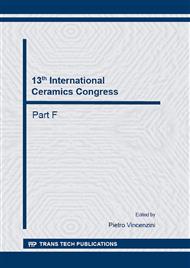[1]
E. K. Tschegg, Austrian Patent 390 328, Prüfeinrichtung zur Ermittlung von Bruchmechanischen Kennwerten sowie hierfür geeigneter Prüfkörper. (1990).
Google Scholar
[2]
H. Harmuth, Stability of crack propagation associated with fracture energy determined by wedge splitting specimen. Theoretical and Applied Fracture Mechanics, 23 (1995) 103-108.
DOI: 10.1016/0167-8442(95)00008-3
Google Scholar
[3]
E. K. Tschegg, Testing device and appropriate specimen shapes for tests to measure fracture values. Austrian Patent AT 390328 B, registered; (1986) [in German].
Google Scholar
[4]
E. K. Tschegg, New equipments for fracture tests on concrete. Mater Test 33 (1991) 338–342.
Google Scholar
[5]
H. Harmuth, K. A. Rieder, M. Krobath, E. K. Tschegg. Investigation of the nonlinear fracture behavior of ordinary ceramic refractory materials. Mater. Sci. Engng. A 214 (1996) 53–61.
DOI: 10.1016/0921-5093(96)10221-5
Google Scholar
[6]
H. Harmuth, E. K. Tschegg. A fracture mechanics approach for the development of refractory materials with reduced brittleness. Fatigue Fract. Engng. Mater. Struct. 20 (1997) 1585–1603.
DOI: 10.1111/j.1460-2695.1997.tb01513.x
Google Scholar
[7]
K.A. Rieder, E. K. Tschegg, H. Harmuth, Notch sensitivity of ordinary ceramic refractory materials. J. Mater. Sci. Lett. 17, (1998) 675–678.
Google Scholar
[8]
E. K. Tschegg, K.T. Fendt, Ch. Manhart, H. Harmuth. Uniaxial and biaxial fracture behaviour of refractory materials. Eng. Fract. Mech. 76 (2009) 2249–2259.
DOI: 10.1016/j.engfracmech.2009.07.011
Google Scholar
[9]
H. Harmuth, R. C. Bradt, Investigation of refractory brittleness by fracture mechanical and fractographic methods. Interceram (Refract Man) (2010), 6–10.
Google Scholar
[10]
J. E. Dennis, D. M. Gay, R. E. Welsch. Algorithm 573: NL2SOL-an adaptive nonlinear least squares algorithm. ACM Trans Math Softw 7 (1981) 369–383.
DOI: 10.1145/355958.355966
Google Scholar
[11]
T. Auer, H. Harmuth, Numerical simulation of a fracture test for brittle disordered materials. In: Gdoutos EE, editor. Fracture of nano and engineering materials and structures. Proceedings of the 16th European conference of fracture, Alexandroupolis (2006).
DOI: 10.1007/1-4020-4972-2_293
Google Scholar
[12]
S. Jin, D. Gruber, H. Harmuth. Determination of Young's modulus, fracture energy and tensile strength of refractories by inverse estimation of a wedge splitting procedure. Engineering Fracture Mechanics, 116 (2014) 228-236.
DOI: 10.1016/j.engfracmech.2013.11.010
Google Scholar
[13]
C. F. Shih, R.J. Asaro. Elastic-Plastic Analysis of Cracks on Bimaterial Interfaces: Part I—Small Scale Yielding. Journal of Applied Mechanics, 55 (1998) 299–316.
DOI: 10.1115/1.3173676
Google Scholar
[14]
M. Katinger. Versuche zur Ermittlung der Zugfestigkeit und der Bruchenergie mittels einem neuartigen Prüfverfahren. Master Thesis, Chair of Ceramics, Montanuniversität, Leoben, (2012).
Google Scholar
[15]
R.W. Rice. Test-Microstructural Dependence of Fracture Energy Measurements in Ceramics. Fracture Mechanics for Ceramics, Rocks and Concrete. Freimann and Fuller Ed. (1981) 96-117.
DOI: 10.1520/stp28300s
Google Scholar
[16]
H. Harmuth, E. K. Tschegg. A fracture mechanics approach for the development of refractory materials with reduced brittleness. Fatigue and Fracture of Engineering Materials and Structures, 20 (1997) 1585-1603.
DOI: 10.1111/j.1460-2695.1997.tb01513.x
Google Scholar


